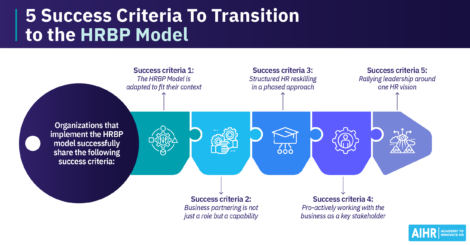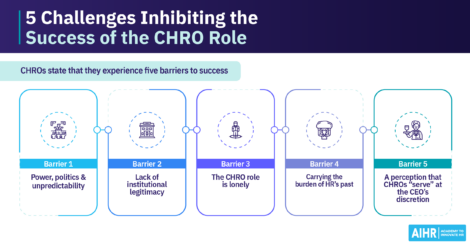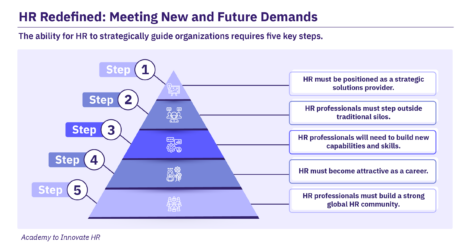Scenario Planning: What HR Needs to Know

With the uncertainty about the emerging world of work, organizations need to deal with ambiguity and, in essence, prepare for multiple futures. Scenario-based planning is becoming an essential strategic capability for organizations and for HR. We believe it is time for HR to play a more central role in scenario planning, specifically focusing on the impact of various scenarios on capability models, skills availability, and talent strategies.
In order to do so, HR practitioners need to understand the scenario planning process, its value for organizations, the implementation process, and how they can contribute to it. Let’s dive in!
Contents
What is scenario planning?
Benefits of scenario planning
The scenario planning process
Why HR is key to the scenario planning process
What is scenario planning?
Scenario planning is an approach that has been widely adopted as part of the strategic planning process. Scenario planning became well-known in the 1960s when companies like Shell started applying this process to better navigate the changing environment concerning oil production and manufacturing.
Even though various definitions exist, scenario planning is essentially about:
- understanding the external dynamics that could influence the operating environment of your business,
- using data to create plausible and possible scenarios for the future
- defining strategic choices that should be explored as a result of each scenario; and
- developing an internal organizational response for each scenario
Scenario planning is rooted in storytelling and the ability to craft a narrative that opens the organization to an alternative future and creates the capacity for change to occur. It is important not to confuse scenario planning with forecasting. Scenario planning does not aim to predict the future but rather to open the organization to the possibility of what the future could entail.
As an HR practitioner, you need to understand the fundamentals of scenario planning. That way, you can contribute to the wider scenario planning process at your organization from the people perspective and also apply it in your HR planning process.
HR plays a key role here, especially in managing the dynamics of the scenario team and helping them break current thinking patterns as part of the scenario planning process.
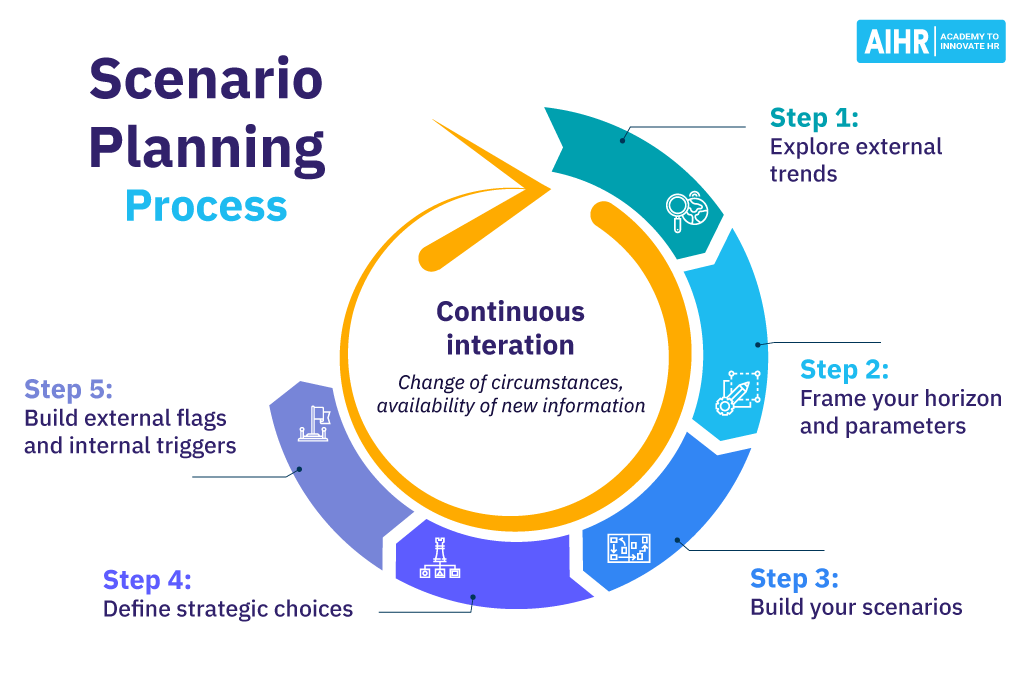
Benefits of scenario planning
The scenario planning process provides several benefits for the organization, such as:
Expanding current thinking and avoiding conformity of ideas
Scenario planning allows the organization to broaden its thinking beyond its current reality. Given the world’s fast-changing nature, organizations must be careful not to fall into the trap of only following one line of thought.
Practically, this implies that organizations should be careful to accept the current strategy and decisions as the only truth. Scenario planning helps you avoid groupthink, constructively encourage non-conformity, and help members involved in the process to broaden their perspectives and view of both the organization and the external operating environment.
For example, a CHRO we spoke to recently had to help his executive team to rethink business processes that had been in place for decades as their business was responding to the COVID-19 pandemic. His role was to ask the difficult questions and pull the team out of the accepted normal.
Create the capacity for change by preparing for various occurrences.
A well-run scenario planning process creates the capacity for the organization to adapt and respond to change.
By considering various scenarios, the organization can already explore responses before these events occur. This, in turn, enables them to be more prepared and deal with ambiguity proactively when it does occur.
For example, scenario planning could help anticipate development needs and programs based on different competency models that HR can develop beforehand to ensure access to the right skills development strategies as scenarios become a reality.
Risk reduction by creating awareness of possible threats
Another benefit of scenario planning is that it helps the organization uncover potential risks and create a proactive mechanism for risk monitoring and mitigation. Scenario planning creates a framework of external flags that the organization actively monitors to identify when specific scenarios will become a reality and allows the organization to mitigate potential risks.
A recent example was a CHRO that identified that labor legislation regarding outsourcing firms would be a potential flag that posed risk to the future talent strategy as this would impact a large part of the current workforce and make current contracts untenable.
The biggest criticism against the scenario planning approach is that it can be too theoretical. If leadership teams are not actively bought into its value, they might see the exercise as a waste of valuable time and resources. To combat this criticism, a well-structured process needs to be in place to drive value.
The scenario planning process
The process of scenario planning differs from method to method and from one organization to another. For the purpose of this article, we will explain a generic approach that highlights the central premise of the scenario planning process.
Step 1: Explore external trends
In this step, companies utilize external data to identify macro trends that could potentially influence the business. It involves exploring current market trends and using available data to determine the relevance of certain trends. Importantly, this step is not about creating new trends but rather identifying the relevance of well-researched trends and determining their possible impact on the organization.
For instance, the aging population and decreasing population growth were explored by a retailer of baby diapers in Japan and Germany. This led to a decision to diversify product development into adult homecare products to mitigate the risk of diminishing returns in the newborn market.
Step 2: Frame your horizon and parameters
Most scenario processes utilize various time horizons to make scenarios more robust and focus on a medium to a longer-term timeframe. Depending on the business and industry, this could range from 5 to 20+ years.
The longer the time frame, the more theoretical scenarios tend to become, as organizations need to make several assumptions to define solid scenarios. If your organization is new to the process, it is better to first work within a shorter time frame.
During this step, the organization also frames the parameters of the scenario process by setting boundaries. Specifically, this entails defining:
- What is the question that we hope to explore when creating these scenarios?
- What will we not explore, and what is out of scope for our scenario?
- What assumptions are we making when creating scenarios?
For example, an organization in the health industry explored potential scenarios of privatizing the healthcare system. For them, the questions to explore ranged from various degrees of privatization and its impact on their operations. They set a boundary to not explore political scenarios in the country, even though these would influence their scenarios. Instead, they focused on more specific questions related to their context.
This is an important point. Setting the scenarios too broad will create scenarios that will be too high level and not inform any concrete responses. Similarly, setting the parameters too narrow will result in scenarios that do not encourage new thinking and remain too close to the current reality.
Step 3: Build your scenarios
Working within a multi-disciplinary group, formulate 3 to 5 scenarios in terms of different levels of probability. It’s important to build scenarios upon data that enables participants to make informed choices about possible futures.
Depending on the approach, organizations should be building at least one worst-case scenario, a best-case scenario, and a probable alternative scenario. Scenarios are not mutually exclusive, so be clear about the differences within each scenario.
To use an example from practice, let’s evaluate a grocery retailer with a large national footprint. They used scenario planning to understand the impact of digital platforms and online shopping on their business. The scenarios below were created in response to the external trend of retailers entering the online shopping market and enabling consumers to buy groceries online and have them delivered to their door:
- Worst case scenario – eCommerce enters the grocery retailer domain, and the need for a physical grocery story footprint diminishes. Consumers want online services and are prepared to pay more for the convenience of getting their groceries delivered. Fast-moving players with better technological capability flood the market and build a stronger distribution network to meet online delivery demand.
- Best case scenario – eCommerce has gained some traction in the grocery and retail market. However, there is still a need for a strong physical presence in stores across the country. We can partner with third parties to meet the demand of the online consumer and use our local grocery stores as depot hubs that utilize our current logistics network to meet the demands.
- Mid-range scenario – eCommerce becomes an integral part of the business to complement the physical grocery store footprint. By enabling online options, we can expand our market to smaller towns where it did not make sense previously to have a physical store by allowing deliveries and orders during the week to these consumers.
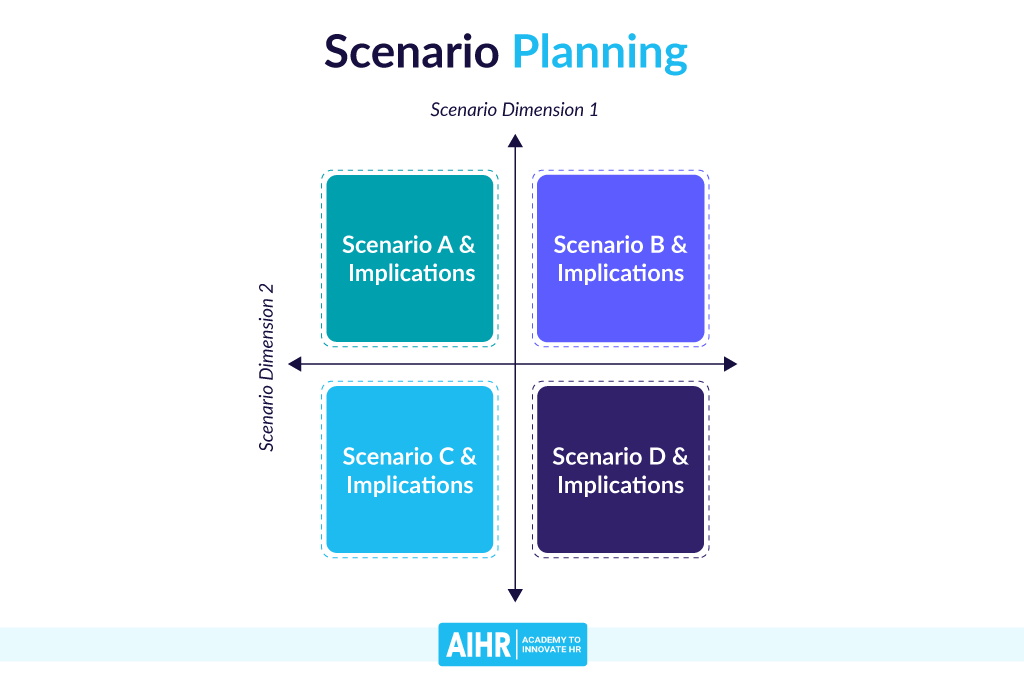
Step 4: Define strategic choices
Once you’ve created and validated your scenarios, the team needs to decide on the strategic choices they have to inform scenario responses. A strategic choice indicates alternative responses based upon the assumptions of each identified scenario.
To take our grocery retailer as an example:
By reviewing the crafted scenarios, the company faces some strategic choices that they need to explore. They need to clarify the desired response and action that the organization will take should these scenarios become a reality:
- Strategic choice 1: Do we want to compete in the eCommerce market?
- Strategic choice 2: Do we believe product diversification will retain current and bring new consumers to our stores?
- Strategic choice 3: Do we invest in building an online eCommerce capability?
- Strategic choice 4: Do we partner with others to extend our delivery distribution service?
- Strategic choice 5: Given our size, can we compete with the new players entering the market by pushing down our prices?
The purpose of this step is to generate a variety of actions that the organization can consider in response to the scenarios above. Once you’ve developed a list, categorize it into themes that deal with choices of a similar nature.
So, for instance, you could group strategic choices related to “Pricing” together. Other categories could include “Capability and skill,” “Logistics,” and “Partnerships.” The organization should define a desired strategic response that coincides with the scenario for each of these categories.
For our grocery store example, we could define the following for the best-case scenario:
| Best case scenario | Category of options | Our strategic response |
| eCommerce has gained some traction in the grocery and retail market. However, there is still a need for a strong physical presence in stores across the country. We can partner with third parties to meet the demand of the online consumer and use our local grocery stores as depot hubs that utilize our current logistics network to meet the demands. | Real estate | Reduction in new real estate investment and freeze current expansion projects, yet maintenance of existing footprint remains a priority. Do not renew current leases and consolidate real estate assets. |
| Delivery and logistics | Expand logistics capability and invest in additional skills and technologies. Also, invest in creating viable partnerships to complement the core delivery value chain. | |
| Pricing | Reframe pricing to make eCommerce options viable and balance revenue streams between in-store and delivery businesses. | |
| Product diversification | Expand in-store products beyond current product categories to enhance in-store attraction. | |
| Platform technologies | Build and invest in consumer platforms for online delivery business to create a consistent customer experience between virtual and physical processes. | |
| People | Create an internal digital and coding skills hub to manage our online eCommerce platform. |
The team should evaluate the available choices for each category and determine the impact and response for each option. For example, if the grocery retailer decides to amend their real estate investment, what would be the impact in terms of:
- Currently available skills versus the skill requirements
- Funding and infrastructure requirements to set up this capability
- Implications for our current leases and contracts
During this step, the risk for the project team is getting caught up in the detail of each scenario. A good rule of thumb is to highlight the major impacts, rank them in importance and only explore the high priorities at this stage. If the scenario becomes more probable over time, you can consider deeper exploration, but at this stage, a high-level perspective is more than sufficient.
Step 5: Build external flags and internal triggers
The last step in the scenario planning process is identifying external flags and internal triggers that help us monitor when our designed scenarios are becoming more or less probable.
External flags are developed as specific events to “watch out” for. They will tell us that the probability of a scenario occurring is increasing/decreasing. Internal triggers dictate a response to a flag that will help the organization systematically shift to prepare and move closer to the designed response.
In our grocery example, a flag that could be identified for the worst-case scenario is when new delivery partners receive significant funding, and regular customers start switching to these options. By viewing these events, we can see that the worst-case scenario is becoming more probable.
So, if the grocery retailer made the strategic choice to change pricing strategies to make the new players seem extremely expensive, this flag would indicate that it is time to consider putting this strategy into action.
Why HR is key to the scenario planning process
As can be seen from the example discussed in this article, involving HR in the core scenario team is beneficial for several reasons. Beyond the people perspective, we believe that HR significantly contributes to building scenarios that:
- enable organizational change and culture,
- help leaders understand their role in creating the capacity for change,
- and highlight people risks that at times are not evident during the initial scenario-building process.
Doing this, however, will depend on the business acumen of the HR professional, their level of credibility with business stakeholders, and robust knowledge of HR contributions and opportunities to manage different scenarios. In our T-shaped HR competency model, this refers to the dimensions of Context Interpretation, HR Mastery, and Strategy co-creation.
All in all, HR professionals play an important role in scenario planning. They:
- Include skills-based workforce planning in the scenario planning process
- Identify and implement relevant HR interventions
- Introduce scenario-based planning within HR itself
Read our article How HR Can Drive Scenario Planning: 3 Opportunities to learn more about what the HR contribution to scenario planning can look like!
A final word
Scenario planning is increasingly important in the unpredictable future. That’s why HR professionals need to develop an understanding of the scenario planning process and its application to business and HR.
Scenario planning is an important tool in the strategic HR professional toolbox. It provides the opportunity to prepare leaders and the organization to deal with the ambiguity of the emerging world of work.
Weekly update
Stay up-to-date with the latest news, trends, and resources in HR
Learn more
Related articles
Are you ready for the future of HR?
Learn modern and relevant HR skills, online






